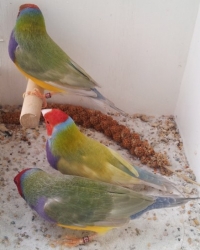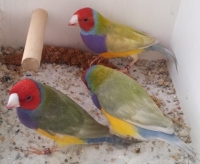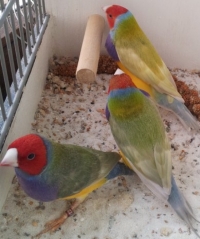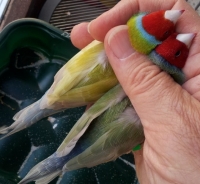Bernhard Größle, 12.09.2012 15:35
Introduction
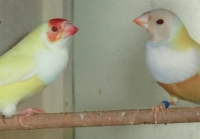
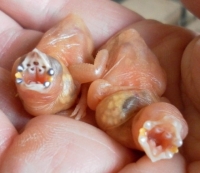
Pre vloženie nového príspevku musíte byť prihlásený.
marek buransky, 12.09.2012 16:33
Hello Bernd.
vítam ťa na tomto diskusnom fóre.
Podľa fotografií to vyzerá, že máš v chove lutino pár. Tie mláďatá sú predpokladám ich potomkovia.
Pre posilnenie tejto mutácie, ktorá je výrazne poznačená imbreedingom, by som skôr volil stepitelného (split) partnera na lutino a druhého partnera lutino. Už si mal tento par v chove v minulosti? Ak áno, ako bolo presne sfarbene ich potomstvo?
Určíte bude veľa ľudí rado, ak pošleš ďalšie fotografie a najmä fotografie, ako sa vyvíjajú tie mláďatá.
Slabšia angličtina nie je problém, ja si myslím, že kto chce porozumieť, tak porozumie. Dúfam tiež, že fórum si získa ďalších prispievateľov.
Ešte raz ťa tu vítam.
Na novej genetickej kalkulačke a na zapracovaní nových mutácií do jej programu sa intenzívne pracuje.
ahoj.
marek
Hello Bernd.
I welcome you at this forum.
According to the photos, it looks like you have lutino pair in breeding. These chicks are assuming their descendants.
To get streng this mutation, which is significantly affected by imbreeding, I would rather vote for splitting partner to the lutino and other lutino partner. Have you had this pair in the past in breeding? If yes, how exactly were coloured their offspring?
A lot of people will like it, if you send more photos and especially photographs as they develop young.
Weaker English is not a problem, I think that anyone who wants to understand will understand you. I also hope that the forum will attract more contributors.
Once again I welcome you here.
At the new genetic forecast and at the incorporation of new mutations in its program we work hard.
hello.
marek
Pre vloženie nového príspevku musíte byť prihlásený.
Bernhard Größle, 12.09.2012 19:05
Thank for your nice words. Of course I will try to elaborate my English that everyone could understand!!??
I have Lutinos from 4 different breeders and I have some split cocks and perhaps split cocks.
Most of my pairings of this season will be split to normal or perhaps split to normal and split to lutino and also Lutino cock with normal females.
I will get some males which are perhaps split but that dos not matter, because I have enough lutinos and some people will be happy to get from such a cock lutino females.
By the way the same I will do with my cinnamons.
Best wishes Bernd
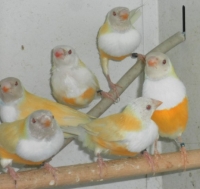
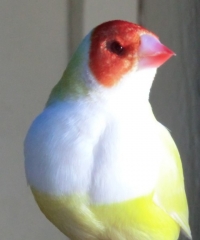
Pre vloženie nového príspevku musíte byť prihlásený.
marek buransky, 12.09.2012 20:28
U teba to vyzerá na veľmim dobrý chovateľský kmeň. Párením split samčekov s lutino samičkami, alebo lutino samček x zelená samička je určite dobrá kombinácia.
Je o lutino vtáky v zahraničí záujem? Čo by si odporučil chovateľom, ktorý by chceli túto mutáciu odchovávať?
Ako je to so životaschopnosťou mláďat ? u môjho priateľa sa teraz objavila škorica u modréhom páru, zanedlho dám na fórum fotografie, je to zaujimava mutácia.
ahoj
Marek
Pre vloženie nového príspevku musíte byť prihlásený.
marek buransky, 12.09.2012 20:30
By you it looks for a really good breeder strain. Mating with split males and lutino females, or lutino male x green female is definitely a good combination.
Are abroad interested in lutino birds? What would you recommend to breeders who would like to breed this mutation?
How is it about the viability of offspring? By my friend has now discover cinammon by blue pair. Soon I willgive at forum photographs, it is interesting mutation.
hello.
marek
Pre vloženie nového príspevku musíte byť prihlásený.
Nektarios Gelias, 13.09.2012 15:02
Hello Bernhard
welcome to this great community.
I am really impressed with your lutino collection , keep the good work
and lets make this forum even greater than it is
Nektarios Gelias
Pre vloženie nového príspevku musíte byť prihlásený.
Bernhard Größle, 13.09.2012 15:54
This 2 blue boys were perhaps split lutino. One of them is in the meantime proved to be split and a blue lutino so called Albino female is the result!
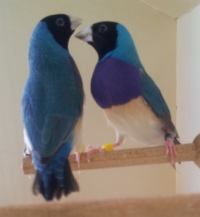
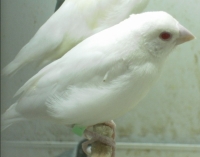
Pre vloženie nového príspevku musíte byť prihlásený.
Bernhard Größle, 13.09.2012 16:33
I will do furthermore my best!
But I forgot to ask especially Marek!
What do you think could it be that my 2 blue boys show the dark factor?
But this should be perhaps diskussed in genetics!
I am very Interested to learn more about the dark factor.
Does everybody knows more?
Thanks Bernd
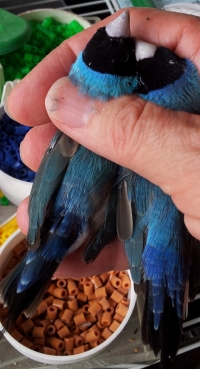
Pre vloženie nového príspevku musíte byť prihlásený.
Marek Buranský, 13.09.2012 19:45
Greetings,
It is hard to tell whether the photograph shows a Dark Factor. It would be better to take a picture of one ordinary blue colored bird and the bird which is suspected to be a Dark Factor carrier so it is possible to observe differences in coloring. Otherwise a single picture might be misleading.
Dark Factor does not cause increase in dark pigment levels, it is an optic effect. That is why only the feathers change color, while the legs, claws or beak do not.
Structural darkening factor – DARK Factor
With this mutation the levels of black pigment (eumelanin) do NOT increase. Dark Factor changes the structure of the medulla – the structure densifies, the dimensions are smaller than under normal circumstances. With the change – the denser structure of the medulla we get a different shade due to interference of the resulting blue light than the natural green color. When the blue structural light crosses the cortex a darker shade is created and the result is a darker colored specimen. The Dark Factor only changes the ratios in the medulla, therefore it causes the change of the shade of the blue structural light thus changing the shade of the entire plumage coloring. With this mutation no additional black pigment is produced. The Dark Factor does not cause darkening of the skin or claws. The Dark Factor is an incompletely dominant mutation. It changes the structure of the photonic nanostructure – medulla, if it is present.
1. The blue line:
- Partial change – single factor (1f), we get a single-factor dark
blue specimen (Dd – old term dark blue)
- Significant change – double factor (2f), we get a double-factor
dark blue specimen (DD – old term mauve)
As chromosomes are always paired, a single specimen may not have more than two Dark Factors (Dark Factor may only mutate once for every chromosome). The heredity is incompletely dominant.
Kind regards.
Marek Buransky
Zdravím vás.
Podľa fotografií je ťažko posúdiť, či ide o Dark faktor. Bolo by dobre nafotiť na jeden záber klasicky modro sfarbeného vtáka a vtáka, u ktorého sa predpokladá, že je nositeľom Dark faktoru, aby bol vidieť rozdiel v sfarbení. Fotografia inak môže byt nepresná.
Dakr faktor nemá za následok zvýšenie množstva tmavého pigmentu, ide len o optický jav. Preto sa mení len farba peria, farba nôh, pazúrikov a zobáka ostáva nezmenená.
Štrukturálny stmavujúci faktor – DARK factor
U tejto mutácii NEJDE o navýšenie množstva tmavého pigmentu (eumelanínu). Dark faktor mení štruktúru v medulle - prichádza k zhusteniu štruktúry, rozmery sú menšie ako za štandardných podmienok. Pri zmene – zhustenie štruktúry v medulle, dostaneme odlišný odtieň interferenciou vytvoreného modrého svetla, než je u prírodnej zelenej farby. Prechodom modrého štrukturálneho svetla cez cortex sa vytvára tmavší odtieň a vo výsledku tak dostaneme tmavšieho jedinca. Tmavý faktor mení len pomery v medulle, teda spôsobuje zmenu odtieňa modrého štrukturálneho svetla a tím mení celkový odtieň sfarbenia peria. Pri tejto mutácii teda neprichádza k navýšeniu tmavého pigmentu. Dark faktor nespôsobuje stmavnutie kože ani pazúrikov. Tmavý faktor je neúplne dominantnou mutáciou. Mení štruktúru fotonickej nanoštruktúry – medully, ak je prítomná:
1. v modrej rade:
- čiastočná zmena - jeden faktor (1f), dostaneme jednofaktorového tmavomodrého jedinca (Dd - starší názov (tmavomodrý)
- ak nastane výrazná zmena - oba dva faktory (2f), dostaneme dvojfaktorového tmavomodrého jedinca DD - starší názov (mauve)
- dd bez faktoru tmavnutia
Pretože chromozómy sa vždy vyskytujú v pároch, nemôže mať jedinec viac ako dva tmavé faktory (tmavý faktor môže zmutovať na každom chromozóme len raz). Dedičnosť je neúplná dominantná.
Marek Buransky
Pre vloženie nového príspevku musíte byť prihlásený.
Bernhard Größle, 14.09.2012 06:07
Can anybody else show pics of dark factor gouldians comparing normals with dark factors?
Best wishes Bernd
Pre vloženie nového príspevku musíte byť prihlásený.
Bernhard Größle, 14.09.2012 19:28
Bernd
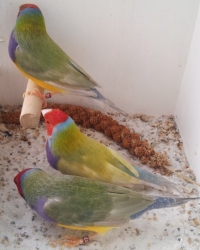
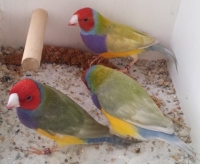
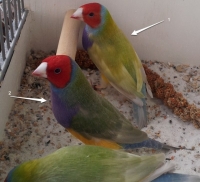
Pre vloženie nového príspevku musíte byť prihlásený.
Marek Buranský, 16.09.2012 21:00
Hello Bernd
I am afraid that dark factored birds are between the breeders few, so I do not know if somebody will give a pic, too.
It is a pity that it is can not see legs of darker blue birds, therefore their color, which could not be changed by the dark factor.
It can be dark factor or a modification of blue when it does show in darker tone.
Just the offspring will show if it is a dark factor, since this is dominant (It will shows in F1 generation, yet)
Otherwise the birds are really nice and I will be interested to buy them, if will be they for a buy.
with sincerely
marek
zdravím Bernd
Obavám sa, že vtákov s Dark faktorom je medzi chovateľmi dosť málo, takže neviem, či niekto prispeje fotografiou.
Je škoda, že tým tmavším modrým vtákom nie je vidieť nohy, teda ich farbu, ktorá pri Dark faktore nesmie byť zmenená .
Môže ísť o Dark faktor, alebo o modifikáciu modrej, kedy sa prejavuje v tmavšom odtieni.
Či ide o Dark faktor ukáže až potomstvo, keďže táto vloha je dominantná, objaví sa už v generácii F1.
Inak vtáky sú veľmi pekné a mal by som záujem o kúpu, ak budú na predaj.
S pozdravom.
marek
Pre vloženie nového príspevku musíte byť prihlásený.
Bernhard Größle, 17.09.2012 17:35
May be somebody have such dark colored birds and will present us some pics here????
Could it be that one factor dark colored birds will have cobalt blue on the back between the wings?
And another question: I have one factor pastell males which are very light greenyellow and other with a dark blueish color one the back. Could this be a sign for dark faktor?
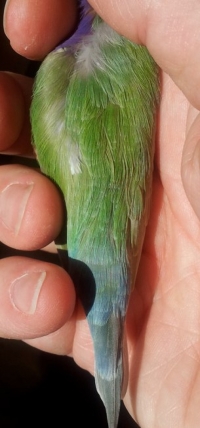
Pre vloženie nového príspevku musíte byť prihlásený.
Marek Buranský, 18.09.2012 14:43
Hello Bernhard.
Dark faktor is a dominant sign and it will show on the all feathering. It´s seen the most where is the black eumelanin and where is a blue color creating. If the birds have signifficant blue it can be a modification which isn´t hereditary or it can be a mutation - Dark faktor and this change is hereditary and it transformed to an offspring.
According to the offspring you can see the most if they have in genes a dark factor.
If I should say if pastel can carry a dark factor I will have to see at pic the both birds together to compare them. Because the picture can misrepresent. It can head for variability in intensity of coloring which couldn´t transfer to an offspring.
Please, send me a pic where are the both birds if you can :)
You have a great breeding :)
Marek
Ahoj Bernhard.
Dark faktor je dominantná vlastnosť a prejaví sa na celom operení. Najviac je vidieť na operení, kde sa nachádza čierny eumelanín a kde sa teda tvorí modrá farba. Ak majú vtáky tmavšiu modrú, môže to byť to byť buď modifikácia, ktorá nie je dedičná, alebo môže ísť o mutáciu, teda Dark faktor, táto zmena je dedičná a prenáša sa aj na potomstvo.
Podľa potomstva od takýchto vtákov najlepšie uvidíte, či majú v génoch dark faktor.
Ak by som sa mal vyjadriť, čí ten pastel môže niesť Dark faktor, musel by som na fotografii vidieť oboch naraz, aby sa to dalo porovnať. Samotná fotografia totižto môže skresľovať. Môže ísť totižto len o určitú variabilitu v intenzite sfarbenia, ktorá sa nemusí preniesť na potomstvo.
Pošlite fotografiu, kde sú oba vtáky naraz : )
Máte pekný chov : )
Marek
Pre vloženie nového príspevku musíte byť prihlásený.
Bernhard Größle, 19.09.2012 18:35
Here are some pics of 3 cocks.
One with very light green color I have at first time.
One with "middle" green color - such birds I have from time to time.
And the third with a very dark green back I have the first time.
I do know that SF Pastels have not all the same green back, but those differences I am wondering about!!! Any Idea?
Thanks
Best wishes Bernd.


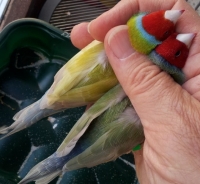

Pre vloženie nového príspevku musíte byť prihlásený.
Bernhard Größle, 19.09.2012 18:37
Pre vloženie nového príspevku musíte byť prihlásený.
Marek Buranský, 19.09.2012 20:21
You´ve got a really interesting breeding tribe of birds. We can´t see such breeding every day. Your last pictures of green pastells males - SF yellow body are interesting and for me they are like puzzle, if you know what I mean. It´s for me a little bit like a riddle.
At a first sight it does look like that the pale bird was cinamon SF yellow and I was thinking if isn´t that a standard DF yellow body, but for it has too intensive turqouise collar so I might be inclined that it´s a cinnamon. That medium green and yellow bird looks like it´s standard SF pastel and that intensive green and yellow looks like a SF yellow plus dark factor.
Can you write me which were their parents? Or possibly send a pic of them? It will really help to clarify the genetics of these birds.
Anyhow these birds are really interesting.
I greet you warmly and thanks for a nice discussion.
Marek
Ahoj Bernd.
Máš skutočne veľmi zaujímavý chovný kmeň vtákov. Také niečo sa vidí málo kde.
Tvoje posledné fotky zelených pastelových samčekov, teda SF yellow sú zaujímavé a sú pre mňa tak trochu hádankou.
Na prvý pohľad to vyzerá tak, ako keby ten bledý vták bol škoricový zelený pastel teda 1F žltý fialovoprsý , zvažoval som aj nad tým, či nejde o štandardného 2 F žltého fialovoprsého samčeka, ale na to má príliš intenzívny tyrkysový golierik, takže asi by som sa priklonil k názoru, že ide o škoricového zeleného pastela. Ten stredne zelenožltý sa mi zdá že je štandardný SF pastel a ten intenzívne zelenožltý vyzerá ako SF pastel + dark factor.
Môžeš napísať, akí boli ich rodičia? prípadne pridať fotku rodičov? To by dosť pomohlo na objasnenie genetiky týchto krásavcov.
V každom prípade ide o zaujímavé vtáky.
Srdečne ťa pozdravujem a ďakujem za príjemnú diskusiu.
marek
Pre vloženie nového príspevku musíte byť prihlásený.
Bernhard Größle, 20.09.2012 19:24
The parents are visually normal birds!
Bird 1 comes from a BH normal colored split Lutino cock. The mother is a RH lutino.
Bird 2 comes from a RH normal colored cock. THe mother is a RH WB pastel.
As you know(?) I have cinnamon Gouldians too. But these birds (as far as I know) are not split to cinnamon.
The idea the first cock could be a "cinnamonpastel" is interesting, but the lutino mother must be a cinnamon lutino and the father must be split lutino.
Perhaps I would give him a cinnamon female to see what will happen!
Best wishes Bernd

Pre vloženie nového príspevku musíte byť prihlásený.
Marek Buranský, 20.09.2012 21:34
The information you provided on the parents shed some light onto the problem. It is a shame that you do not list breast color in the parents as it is very important in lutino and yellow mutations.
Purple breasts act as a darkening factor.
So if the first pair was a green male splitting to lutino and a lutino female, one of the parents had to be purple-breasted, if the male no. 1 is their offspring. From such a pairing we get 25% DF ino, 50% normally colored birds splitting to ino (lutino) and 25% normally colored birds, if we only consider males. So I think that bird no. 1 is albino (or recessive yellow) with purple breasts, which act as a darkening factor. If the bird was white-breasted he would be a lutino male with red eyes. So bird no. 1 carries 2 ino factors.
Male no. 2 is an offspring of a green male and yellow female. The male had to have purple breasts. From such a pairing we get 100% SF yellow (green pastel) males. So male no. 2 is a classic green pastel. If neither of the parents was not a carrier of the DARK factor, their offspring may not carry the DARK factor as well. Since DARK factor is incompletely dominant the phenotype shows even in a SF constitution. If the male was to carry the DARK factor, one of the parents would have to be a carrier of at least a SF DARK factor. It is possible that the yellow female was a DARK factor carrier, since in yellow mutations it demonstrates only a little, so it is possible to mistake it for classic yellow (pastel).
So it is probably not a case of cinnamon in these birds. The probable case is:
Male no. 1 is DF ino + purple breast,
Male no. 2 is SF yellow (pastel green) + SF Dark factor inherited from a yellow female with DARK factor
Male no. 3 with the mediate coloring is probably a classic green pastel (SF Yellow).
Marek
Tvoje informácie o rodičoch vniesli do problematiky trochu viac svetla. Škoda, že u rodičov neuvádzaš farbu pŕs, keďže tá je u lutino a žltej mutácie veľmi dôležitá.
Fialové prsia pôsobia ako stmavujúci faktor.
Takže ak prvý pár bol zelený samček štepitelný na lutino a samička bola lutino, musel aspoň jeden rodič mať fialové prsia, ak je ich potomkom samček č.1. Z takéhoto spojenia rodičov dostávame 25 % DF ino potomkov, 50 % normálne sfarbených vtákov štepitelných na ino (lutino) a 25 % normálne sfarbených vtákov, píšem len o samčekoch. Takže podľa mňa je vták č.1 albino (respektívne recesívna žltá) s fialovými prsiami, ktoré pôsobia ako stmavujúci faktor. Ak by ten vták mal biele prsia bol by to lutino samček a červenými očami. Takže vták č.1 nesie 2 ino faktory.
Samček č.2 je potomkom zeleného samčeka a žltej samičky. Samček musel mať fialové prsia. Z takéhoto spojenia dostávame 100 % samčekov SF yellow – zelený pastel. Takže samček č.2 je klasický zelený pastel. Ak ani jeden z rodičov nebol nositeľom DARK faktora, tak ani ich potomstvo nemôže niesť DARK faktor. Keďže je DARK faktor neúplne dominantný, prejaví sa vo fenotype už v SF konštitúcii. Ak by mal tento samček niesť DARK faktor, aspoň jeden z rodičov by museli byť nositeľom minimálne SF DARK faktora. Je tu ešte možnosť, že tá žltá samička bola nositeľom DARK faktora, keďže ten sa u žltej mutácie prejavuje vo fenotype len veľmi slabo, tak je možné, že si tú samičku pokladal za klasicky žltú (pastelovú).
Takže pravdepodobne nejde o škoricu u týchto vtákov. Pravdepodobne sa jedná o :
Samček č.2 je SF yellow - zelený pastel +SF Dark faktor po žltej samičke s DARK faktorom.
Tretí stredne sfarbený samček je pravdepodobne klasický zelený pastel (SF yellow).
Marek
Pre vloženie nového príspevku musíte byť prihlásený.
Bernhard Größle, 20.09.2012 22:47
Great thanks for your enlightening informations. The fathers of these birds are purple breasts!
I hope I have understand all correctly.
I understand (and agree) what you said about bird number 2 and 3.
Male no. 1 is DF ino + purple breast (does exist Lutinos with purple breast?)
This I do not understand.
The mother is a red head lutino with white breast ( as all european lutinos have???) and
she is pastel too. ( I bought this bird and the breeder got his lutinos from a split lutino WB pastell (SF or DF??) cock - so he said)
Therefore all sons of her are SF pastel. The bird has no red eyes. Therefore I ask you isnt it possible that this bird is a SF pastel split lutino. In this matter the SF lutino must enlighten the pastel bird.
A SF pastell (DF) lutino cock should have red eyes and may have the same color as normal lutinos have.
But this are only my opinions - I am not a specialist.
Thanks for more informations.
Pre vloženie nového príspevku musíte byť prihlásený.
Marek Buranský, 20.09.2012 23:53
You have written that the parents of male no. 1 were a green purple-breasted male splitting to lutino and a lutino (white-breasted) female. From such a pairing we get the offspring as I mentioned before:
25% DF ino offspring (the phenotype is not necessarily lutino), 50% normally colored birds splitting to ino (lutino) and 25% normally colored birds, considering only males.
The purple breast color is important. It acts as a darkening factor.
So a bird might have DF ino, but if it has purple breast color its phenotype will look the same as a DF yellow bird. It will have black eyes and the turquoise collar coloring is partially preserved.
The fact that it has 2 ino factors will only be apparent after mating with a white-breasted female. So your male probably has 2 ino factors. If you breed it with lutino (white-breasted) female you will get the following offspring:
50% males with DF ino, purple-breasted splitting to white-breasted (phenotype like DF yellow with black eyes),
50% lutino males (white-breasted, red eyes)
50% females with ino factor, purple-breasted splitting to white-breasted (phenotype like yellow purple-breasted with black eyes)
50% lutino (females white-breasted, red eyes)
The results might be more interesting if these birds were splitting to blue, then the offspring would contain blue and albino birds.
This is my opinion, though I might be wrong, since I do not know the exact genotype of the parents and grandparents.
Marek
Zdravím Bemd.
U samčeka č.1 ste napísali, že jeho otec bol zelený fialovoprsý štepitelný na lutino, matka bola lutino (bieloprsá). Z takéhoto spojenia dostávame potomstvo ako som už písal, teda:
25 % DF ino potomkov (pozor, fenotyp nemusí byť lutino), 50 % normálne sfarbených vtákov štepitelných na ino (lutino) a 25 % normálne sfarbených vtákov, píšem len o samčekoch.
Dôležité sú fialové prsia!!!. Tie pôsobia ako stmavujúci faktor.
Takže vták môže mať DF ino , ale ak má fialové prsia, tak jeho fenotyp bude vyzerať ako u DF žltého vtáka. Teda bude mať čierne oči a ostáva mu čiastočné tyrkysové sfarbenie golierika.
To, že má 2 ino faktory sa prejaví až pri párení s bieloprsou samičkou. Teda váš samček č.1 má pravdepodobne 2 ino faktory. Ak ho spárite s lutino (bieloprsou) samičkou, dostanete nasledovné potomstvo:
50 % samčekov bude DF ino fialovoprsých štepiteľných na bieloprsé (fenotyp ako DF žltý s čiernymi očami),
50 % samčekov lutino (biele, prsia, červené oči)
50% samičiek s ino faktorom fialovoprsých štepiteľných na bieloprsé (fenotyp žltá fialovoprsá s čiernymi očami)
50% samičiek lutino (biele prsia , červené oči)
Výsledok môže byť ešte zaujímavejší, pokiaľ by tieto vtáky boli štepiteľné na modré, potom by v potomstve boli aj modré a albino.
To je môj názor, no môžem sa aj mýliť, keďže nepoznám presne genotyp rodičov a prarodičov.
S pozdravom.
marek
Pre vloženie nového príspevku musíte byť prihlásený.
Bernhard Größle, 21.09.2012 18:46
Best wishes Bernd

Pre vloženie nového príspevku musíte byť prihlásený.
Marek Buranský, 22.09.2012 00:09
I'm not angry and I don´t mind these questions. The discussion is here to explaining the things that we want to know about. So just feel free to ask questions and if I will know answer to them then I will answer.
As I had written purple breasts (pheomelanin) are factor of darkening. Therefore is SF yellow (pastelgreen) purple breasted photo #1, if the male had SF yellow white breasts the fenotype would be same as in the picture #2. These birds are genotypely the same to the color of their body, thus SF yellow. The different phenotype caused only the coloration of breasts.
Male:
If they have DF ino - homozygous (males) have purple breasts then they will have phenotype as yellow birds with faded turquoise collar and black eyes.
If the birds will be DF ino - homozygous white breasts then they will have lutino phenotype with red eyes.
Female:
Females are hemizygous, they bear for ino factor only one aptitude, so they don´t have paired allele.
Female with ino factor and purple breasts will have yellow phenotype with black eyes.
Female with ino factor and white breasts will have lutino phenotype with red eyes.
Lilac breasts. Lilac breasts tend more colors, it´s going about a loss of one of the factors for pheomelanin and thus is creating less blue structural color.
Since is the pheomelanin reduced, it doesn´t know to succeed as fully as darkening element. So the lilac breasted birds have phenotype practically same as by the white breasted birds.
By the lutino mutation are lilac breasts behave same as by the white breasts and thus bird could have lutino phenotype with red eyes. But it´s likely that DF ino + lilac breasts by males and ino + lilac breasts by females will caused an effect of darker red eye as by the pure white breasts and the color of body wouldn´t be darker yellow. But it caused at the color intensity of lilac breasts. If the birds will have only not significant color of lilac breasts same as it´s at the link which you had sent me, then their phenotype could be practically same with white breasted birds and so they will have lutino phenotype.
But it´s doesn´t matter if the breasts are purple, white or lilac if the ino factored bird, althought it doesn´t seen in phenotype, transffered it to the offspring where the ino factor will manifest (white breasts).
With greetings
Marek
Ahoj Bernd.
Vôbec sa nehnevám a nevadia mi otázky, veď o tom je diskusia, aby sme si veci vysvetlili. Takže kľudne poloz otázky a ak budem vedieť, tak na ne rad odpoviem.
Ako som už písal, trak fialové prsia (pheomelanín) sú stmavujúcim faktorom. Preto je SF yellow zelený pastel fialovoprsý foto č.1, ak by mal samček 1F žltý biele prsia, jeho fenotyp by bol taký, ako je na fotke č.2. Tieto vtáky sú genotypovo rovnaké, čo sa týka farby tela, teda 1F žlté. Ich odlišný fenotyp spôsobuje len sfarbenie pŕs.
Samčeky:
Ak majú DF ino – homozygotní (samčeky), majú fialové prsia, tak budú mať fenotyp ako žlté vtáky s vyblednutým tyrkysovým golierikom a čiernymi očami.
Ak budú vtáky DF ino - homozygotní + biele prsia budú mať fenotyp lutino s červenými očami.
Samičky:
Samičky sú hemizygotné, nesú pre ino faktor len jednu vlohu, teda nemajú párovú alelu.
Samička s ino faktorom a fialovými prsiami bude mať fenotyp žltý s čiernymi očami
Samička s ino faktorom s bielymi prsiami bude mať fenotyp lutino s červenými očami.
Ružové prsia – lilac. Ružové prsia bývajú viacerých odtieňov, jedná sa o stratu jedného faktora pre pheomelanín a tým sa tvorí menej modrej štrukturálnej farby. Keďže je pheomelanín zredukovaný, nedokáže sa už presadiť v plnej miere ako stmavujúci prvok . Teda ružovoprsé vtáky majú fenotyp prakticky totožné s bieloprsými.
U lutino mutácie sa ružové prsia teda správajú podobne ako prsia biele a takýto vták môže mať fenotyp lutino s červenými očami. Je ale pravdepodobné, že DF ino + ružové u samčekov a ino + ružové prsia u samičiek budú spôsobovať efekt tmavšieho červeného oka ako u čisto bielych pŕs a aj farba tela nebude o niečo tmavšie žltá. Záleží však na intenzite ružovej farby pŕs. Ak budú mať vtáky len nevýraznú ružovú farbu pŕs, tak ako je to na linku, ktorý si mi poslal, potom ich fenotyp môže byť prakticky totožný s bieloprsými a budú mať teda fenotyp lutino.
Je ale jedno, či sú prsia fialové, biele, alebo ružové, ak má vták ino faktor, aj keď sa neprejaví vo fenotype, prenáša ho na potomstvo, kde sa za podmienok ( biele prsia) prejaví.
S pozdravom.
Marek


Pre vloženie nového príspevku musíte byť prihlásený.
Bernhard Größle, 22.09.2012 15:09
Nevertheless its astonishing if you compare this lutino inheritance with other birds like budgies.
Just an example:
From the pair on the pic I have 4 chicks one of them is a lutino (must be female).
THe cock: BH split lutino, must split WB
The female: BH normal colored, must split WB
Its a bang for the buck because the mathematical probability is dispersing!!!
So I had luck and I am tensly waiting for the results of the second clutch.
Best wishes Bern
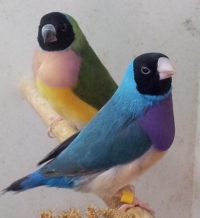

Pre vloženie nového príspevku musíte byť prihlásený.
marek buransky, 22.09.2012 21:45
If helped you my answers, I´m glad. These are only knowledges from teoretic of genetics. I will be glad if you will sometimes report me about your breeding of lutino, albino and birds with dark factor. Of course, everybody will be happy when you will place some pics here at this forum.
To your pair from your last contribution - blue male with purple breasts split to the white breasts and lutino x green female with purple breasts split to the white breasts. From this connection is possible to get a few results.
Perhaps I wasn´t mistaken in the calculations.
I look forward to further discussion.
With greetings
Marek
Ahoj Bernd
Ak ti moje poznámky alebo odpovede pomohli som rád. Sú to však poznatky z teoretickej genetiky. Budem rád ak dáš vedieť, ako sa ti darí v chove lutino, albino a vtákov s dark faktorom. Určite každého potešia fotografie, ktoré umiestniš do tohto fóra.
K tomu páru z tvojho posledného príspevku teda modrý samček fialovoprsý štepitelný na biele prsia a lutino x zelená samička fialovoprsá stepitelná na bieloprsé. Z tohto spojenia je možné dostať niekoľko výsledkov.
Teším sa na ďalšiu diskusiu
S pozdravom
Marek

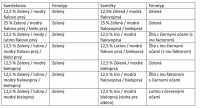
Pre vloženie nového príspevku musíte byť prihlásený.
Bernhard Größle, 23.09.2012 18:23
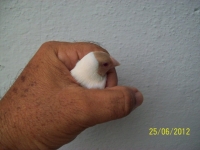
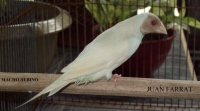
Pre vloženie nového príspevku musíte byť prihlásený.
Marek Buranský, 23.09.2012 21:25
Could you write to Mr. Juan please and ask him for teoretic result of the offspring by your pair, which had we here debate about?
blue male split to the lutino with purple breasts split to the white breasts (BB/ino,PB/WB) x green female with purple breasts split to the white breasts (GB, PB/WB).
Thanks.
Marek
Pre vloženie nového príspevku musíte byť prihlásený.
Bernhard Größle, 25.09.2012 17:03
hello bernd,
for teoric results of the offsprings for this cuple ,we will only take into acount the back color and the breast color and we will assume the female is pure green .
purple breast blue male / for ino and white breast +purple breast green female / for white breast .
MALE + FEMALE
BB/INO ,PB/WB + GB,PB/WB
INO X B PB + X G PB
X B WB Y G WB
RESULTS:
MALES: 6,25 % WB GREEN /B
6,25 % PB GREEN / INO AND B
12,50 % PB GREEN /WB AND B
12,50 % PB GREEN / INO AND WB AND B
6,25 % PB GREEN / B
6,25 % WB GREEN / INO AND B
FEMALES : 6,25 % PB INO / B
12,50 % PB GREEN / B
12,50 % PB INO/ WB AND B
6,25 % WB GREEN / B
6,25 % WB INO / B
6,25 % PB GREEN / B
ALL LUTINOS FEMALES MUST SHOW RED EYES EVEN THOUG THEY HAVE PB.
/= SPLIT FOR
PB=PURPLE BREAST
WB=WHITE BREAST
B=BLUE
Pre vloženie nového príspevku musíte byť prihlásený.
marek buransky, 25.09.2012 19:51
Teoretic results of the offspring, which you published at the forum from the pair about we had written are practically the same with my results. But you have there by the females in results a duplication, althought its probably a mistake:
6,25 % PB GREEN / B
12,50 % PB GREEN / B
In the result by the females I miss:
GREEN body/ Blue body , Purple breast/White breast
INO /Blue body, Purple breast
The difference in these results if we point out the mistake is only in that I was by my females: 6,25 % PB INO / B, a 12,50 % PB INO/ WB AND B, written about that they will have black eyes. In result, which you have published is listed that the females have red eyes althought they have purple breasts.
Are anywhere published the pics from the lutino purple breasts females with red eyes?
With greetings
Marek.
Ahoj Bernd.
Teoretické výsledky potomstva, ktoré si uverejnil vo fóre od toho páru, o ktorom sme písali sú prakticky totožné s mojimi výsledkami. Ovšem ty tam máš u samičiek vo výsledku duplicitu, aj keď sa pravdepodobne jedná len o preklep:
6,25 % fialovoprsé zelené / modré
12,50 % fialovoprsé zelené / modré
Vo výsledku mi u samičiek chýba:
zelené / modré fialovoprsé /bieloprsé
fialovoprsé INO / modré
Rozdiel v týchto výsledkov, ak opomenieme preklep je len v tom, že ja som u samičiek: 6,25 % PB INO / B, a 12,50 % PB INO/ WB AND B, písal o tom, že ba mali mať čierne oči. Vo výsledku, ktorý si zverejnil ty je uvedené, že samičky majú červené oči, aj keď majú fialové prsia.
Sú niekde zverejnené fotografie lutino fialovoprsých samičiek s červenými očami?
Zdravím ťa.
marek
Pre vloženie nového príspevku musíte byť prihlásený.
Bernhard Größle, 26.09.2012 12:26
He wrote:
THIS WAY RIGHT
My opinion:
Pre vloženie nového príspevku musíte byť prihlásený.
Odoberanie vajíčok a ich následná inkubácia
02.11.2016 - Kniha o chove amadín Gouldovej.
http://gfinches2.com/
http://www.gouldamadine.de/
http://www.novaexota.eu/
http://www.epapousek.cz/
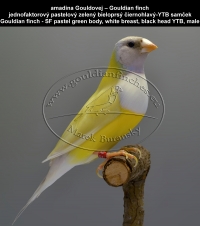
stránok www.gouldianfinchces.eu
Kontakt:








